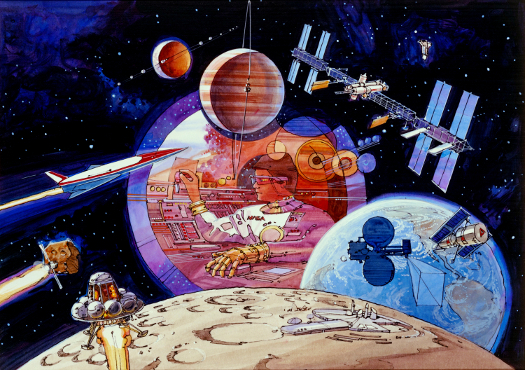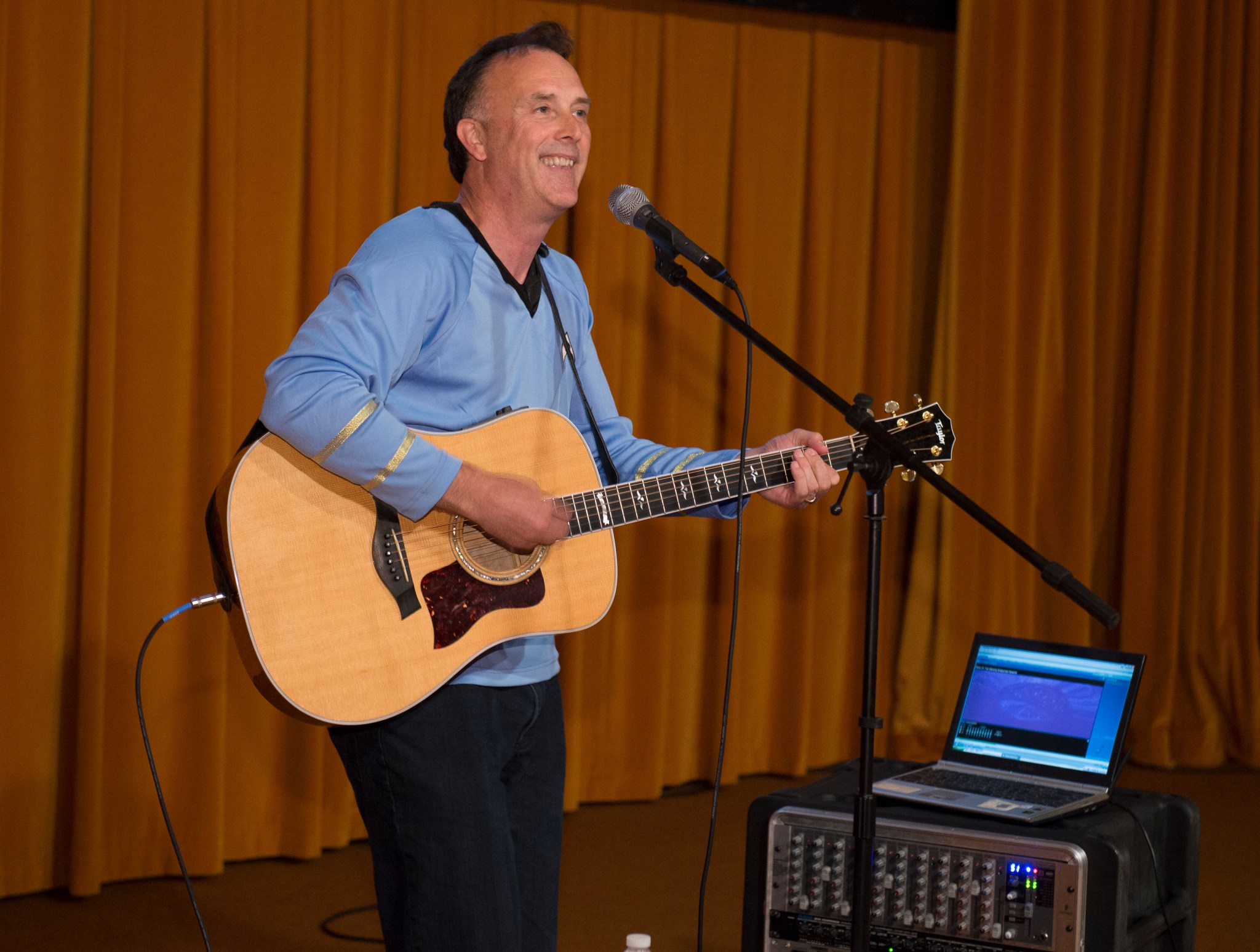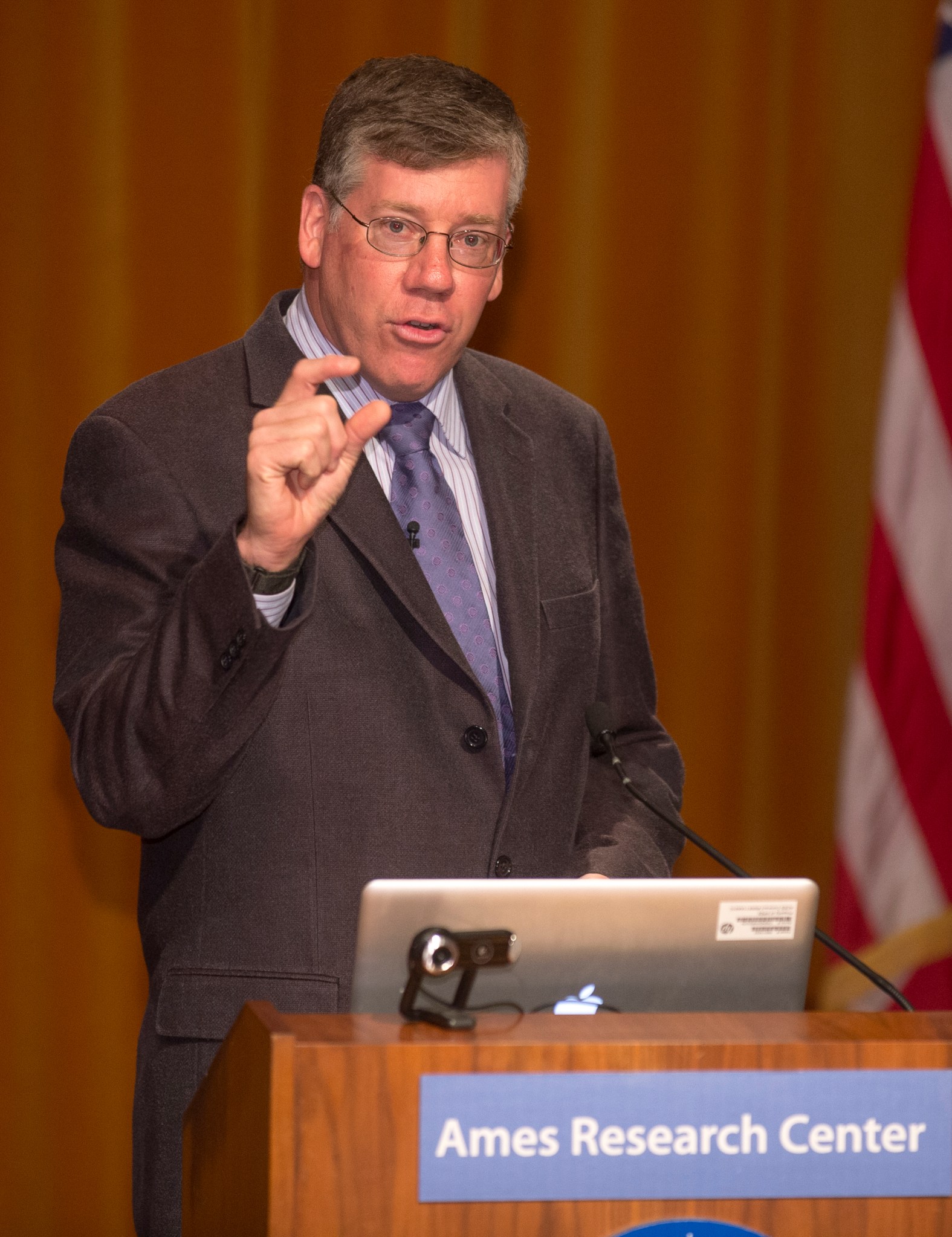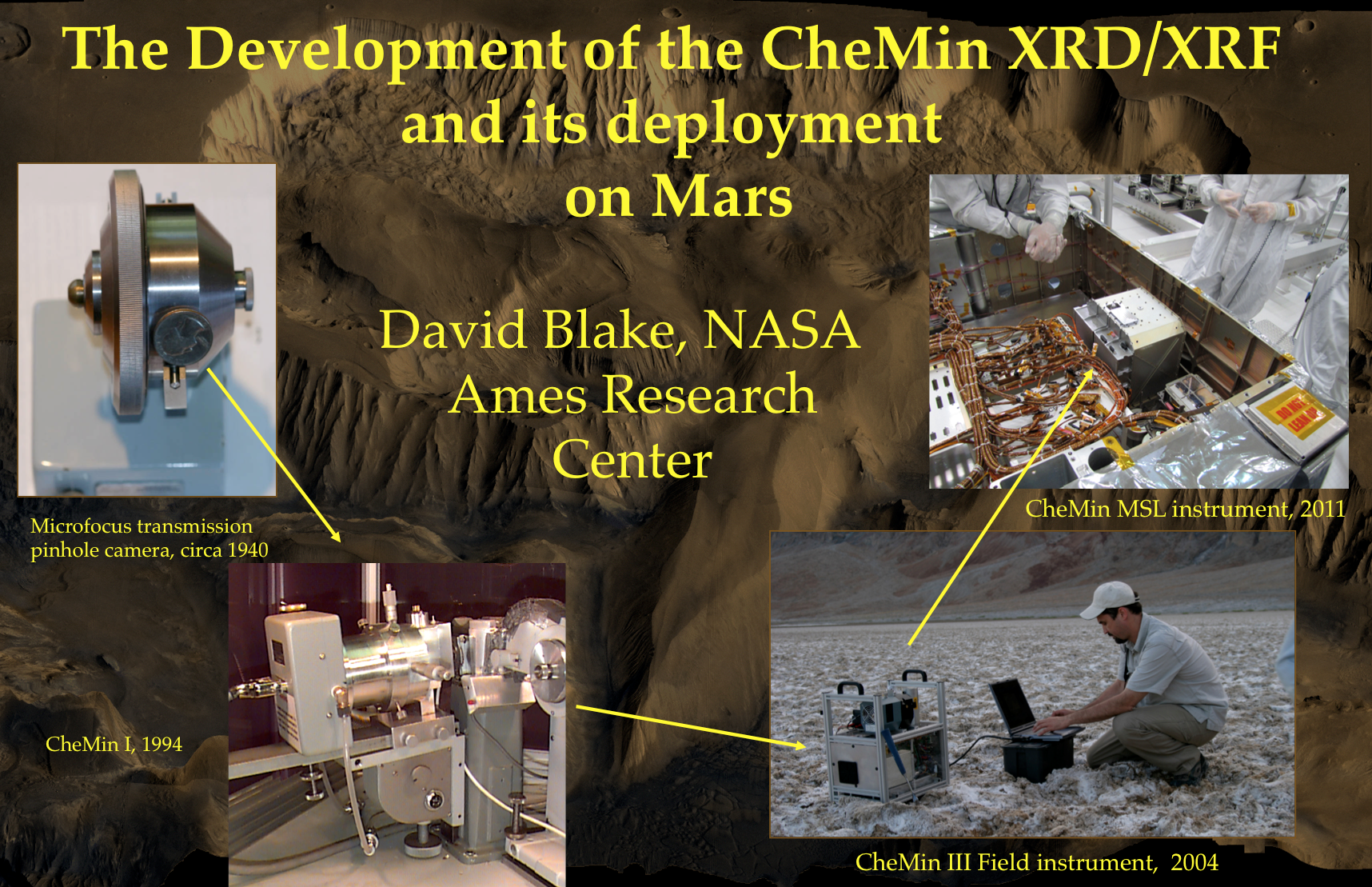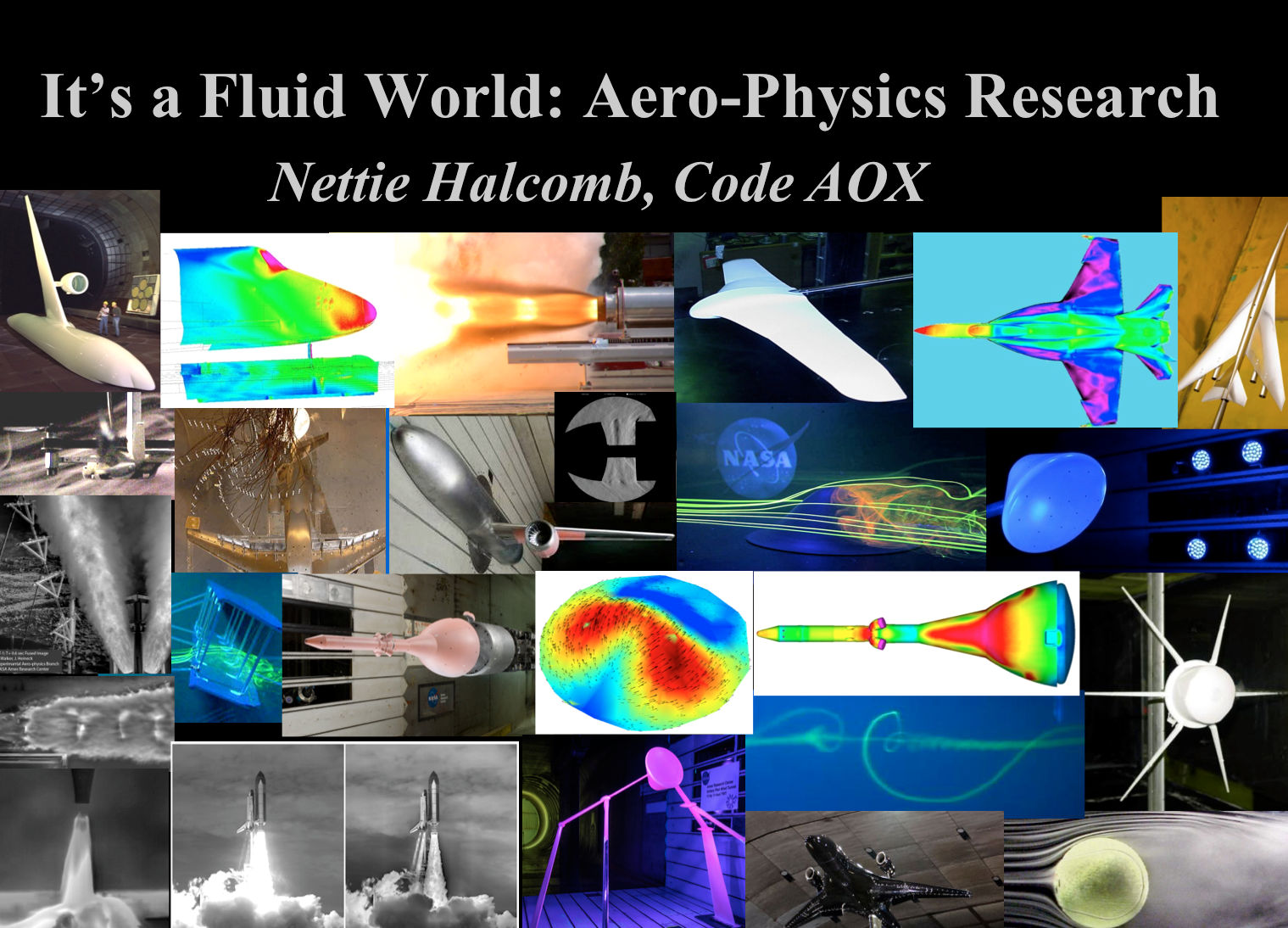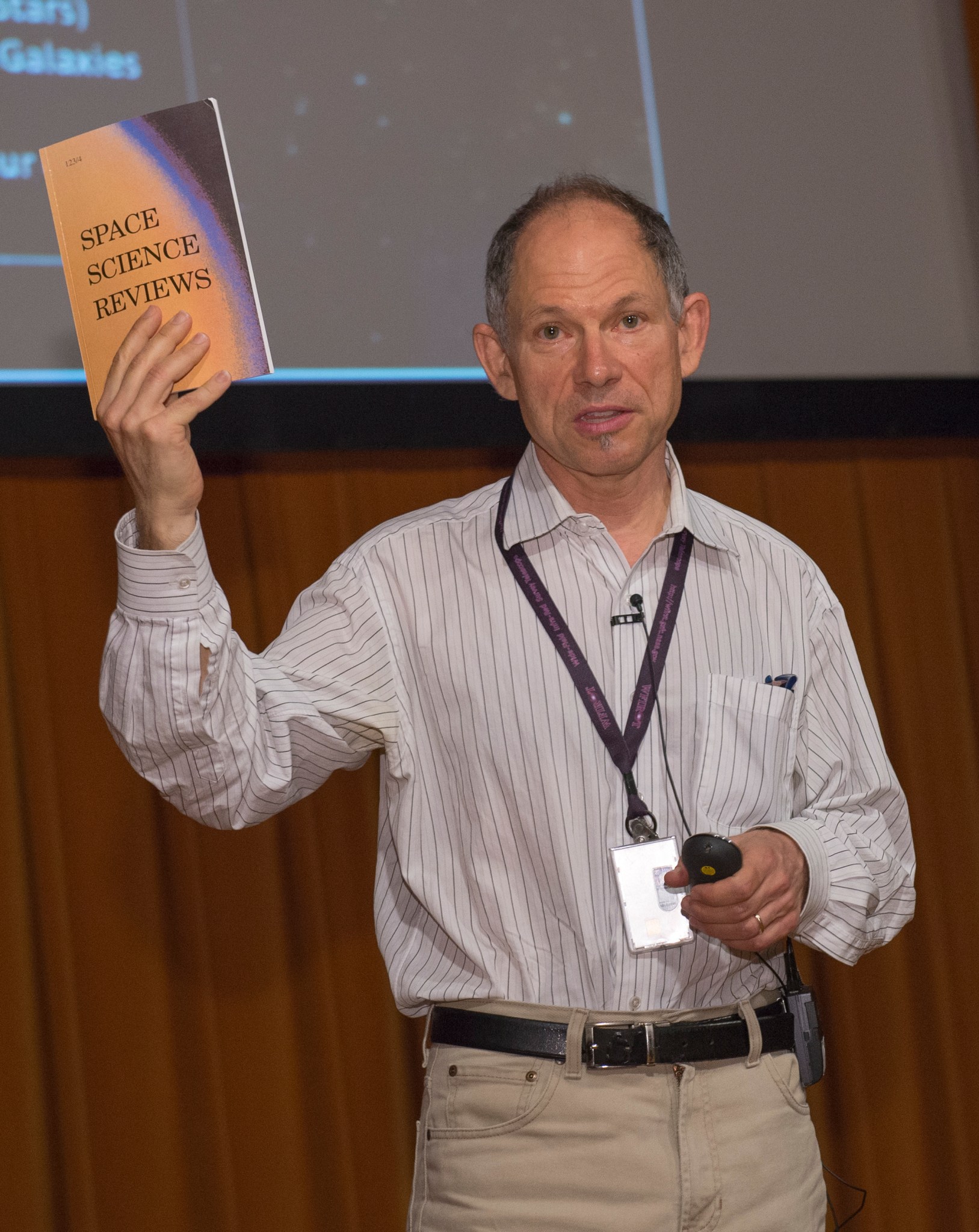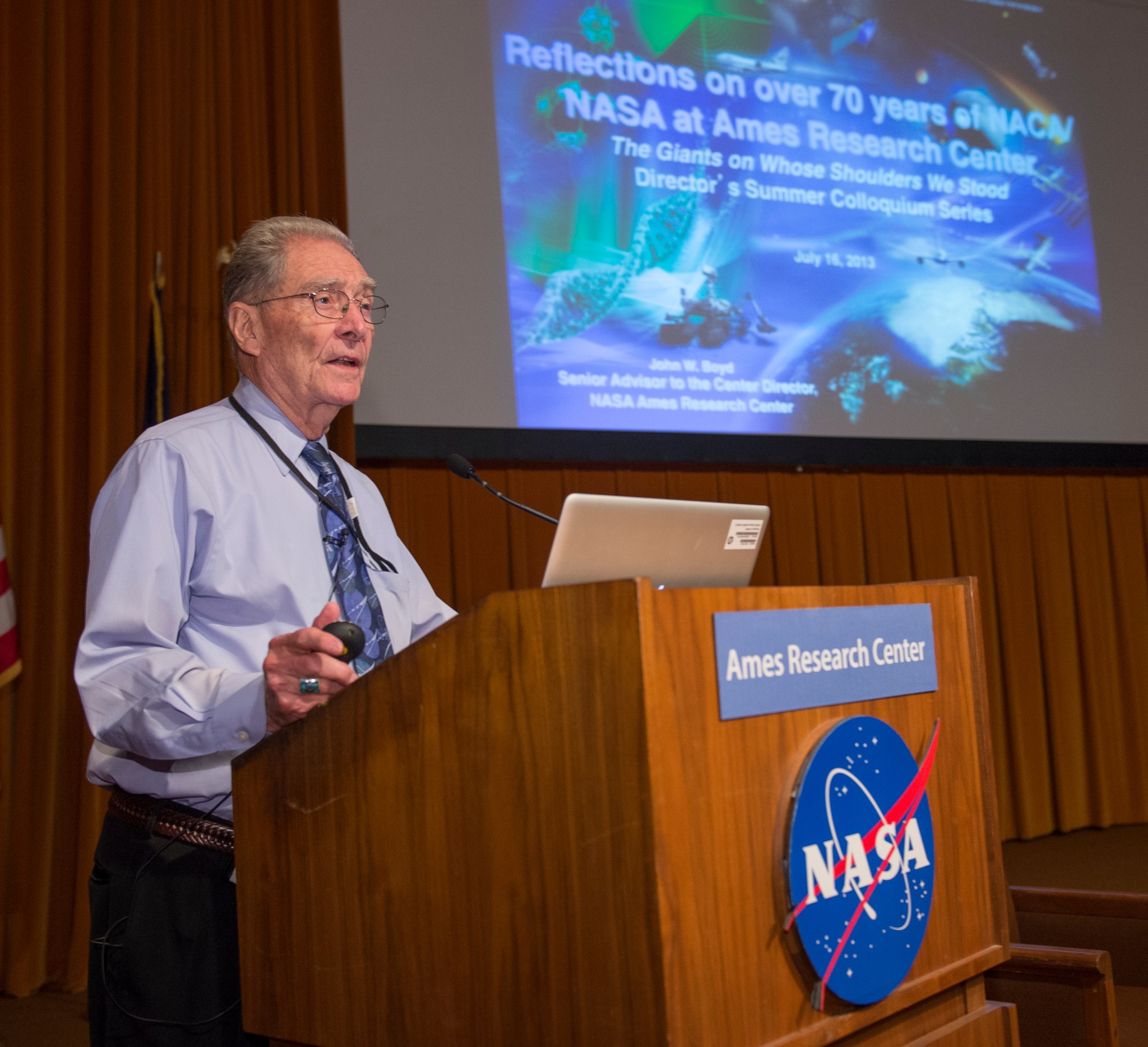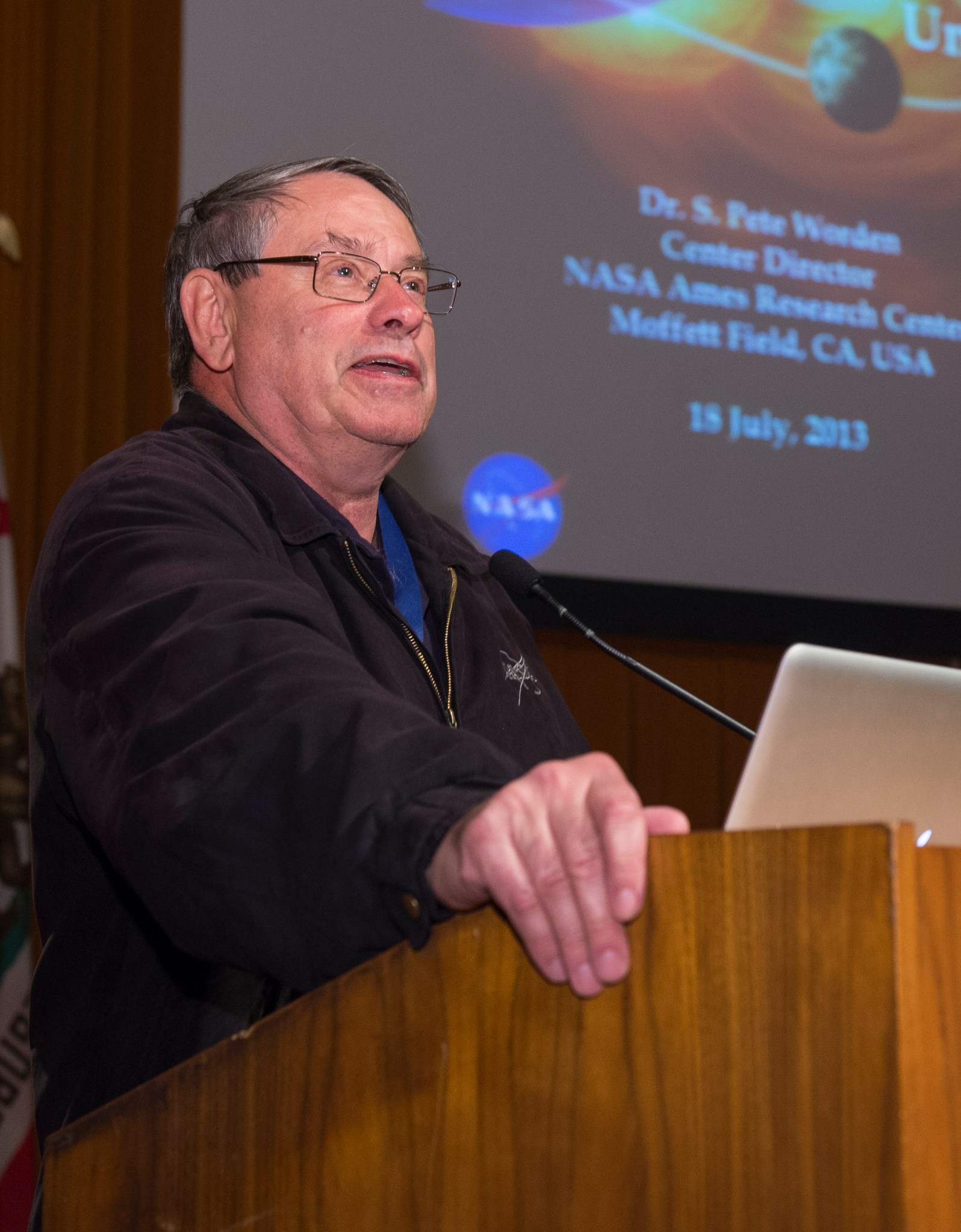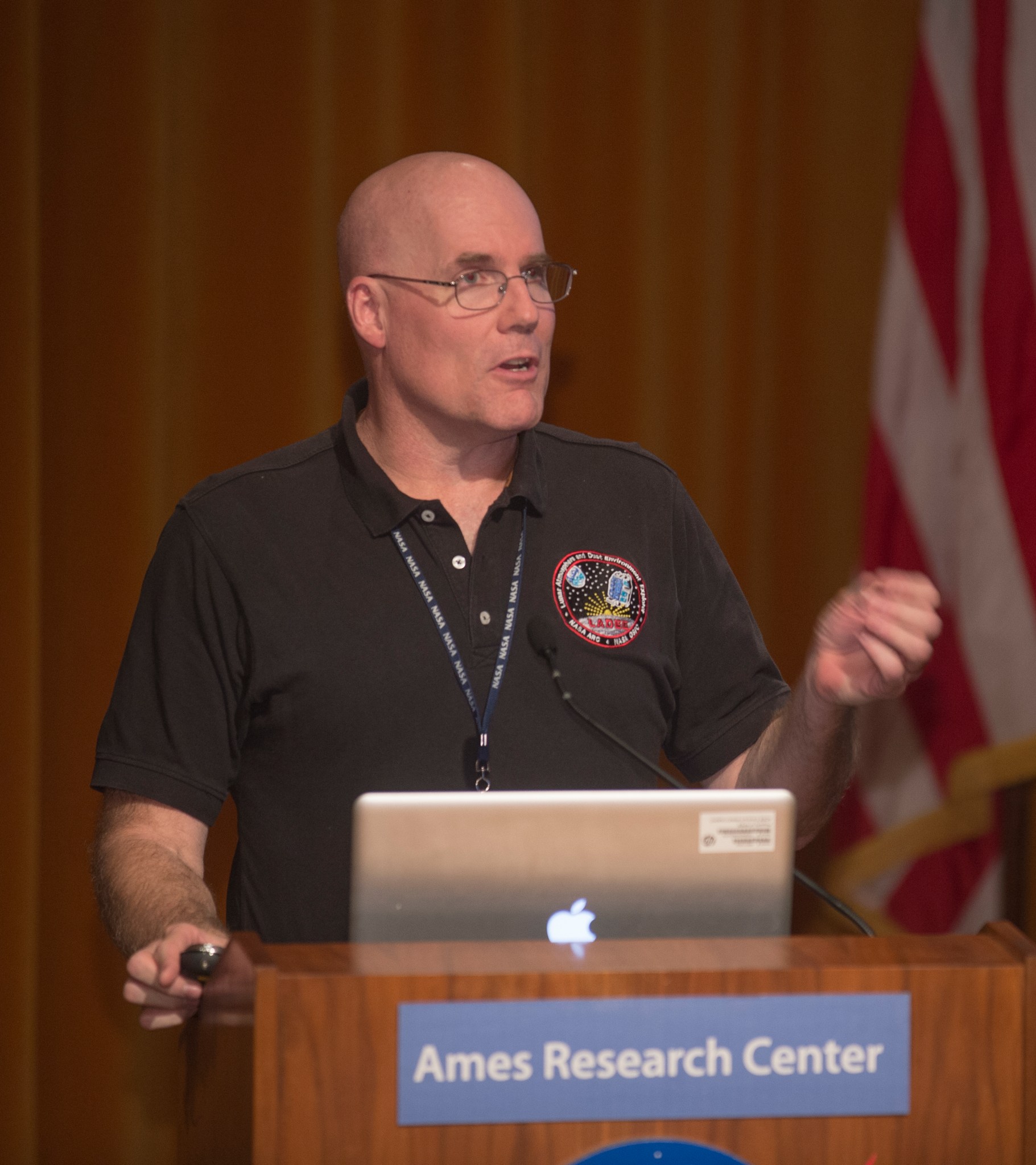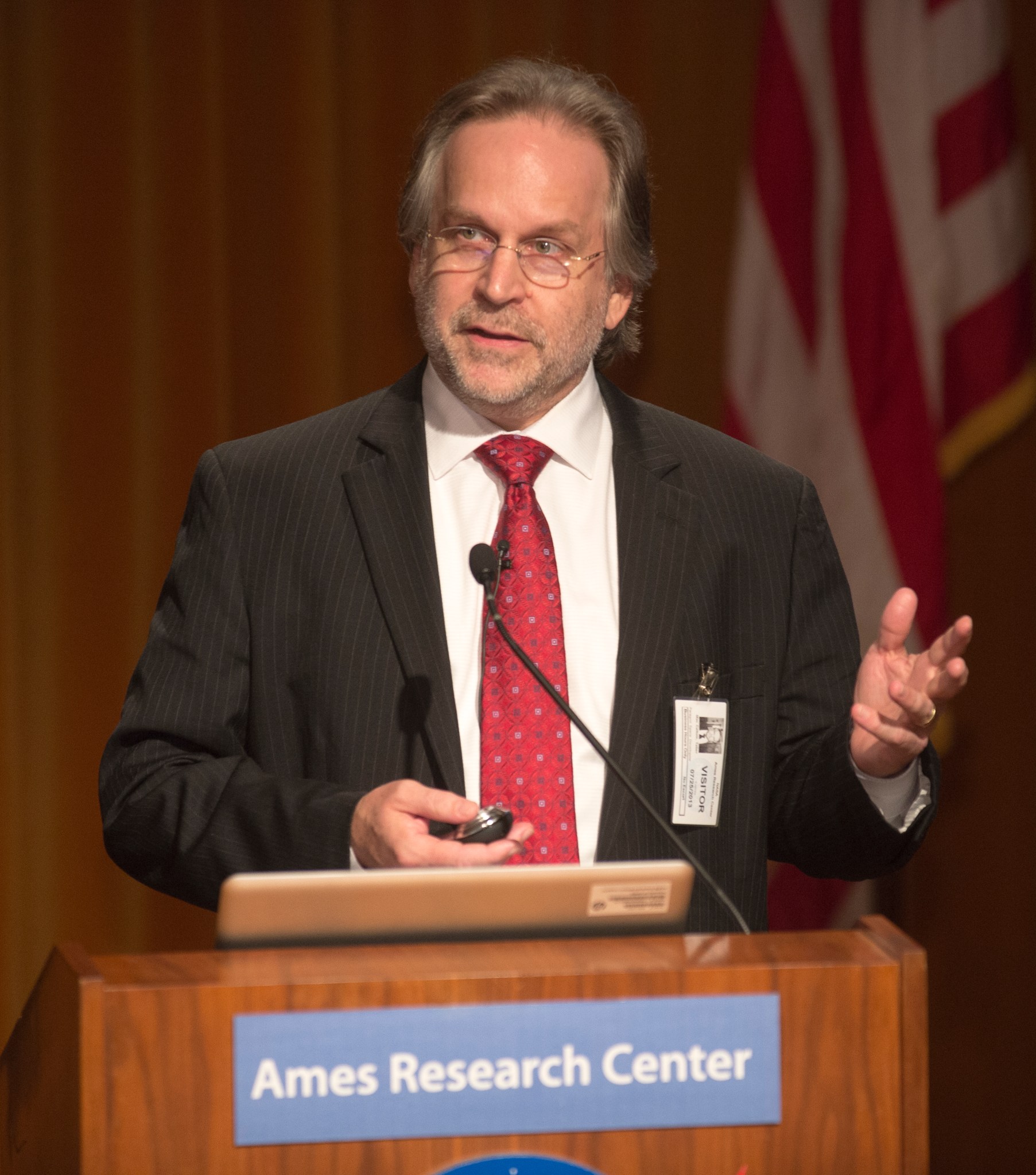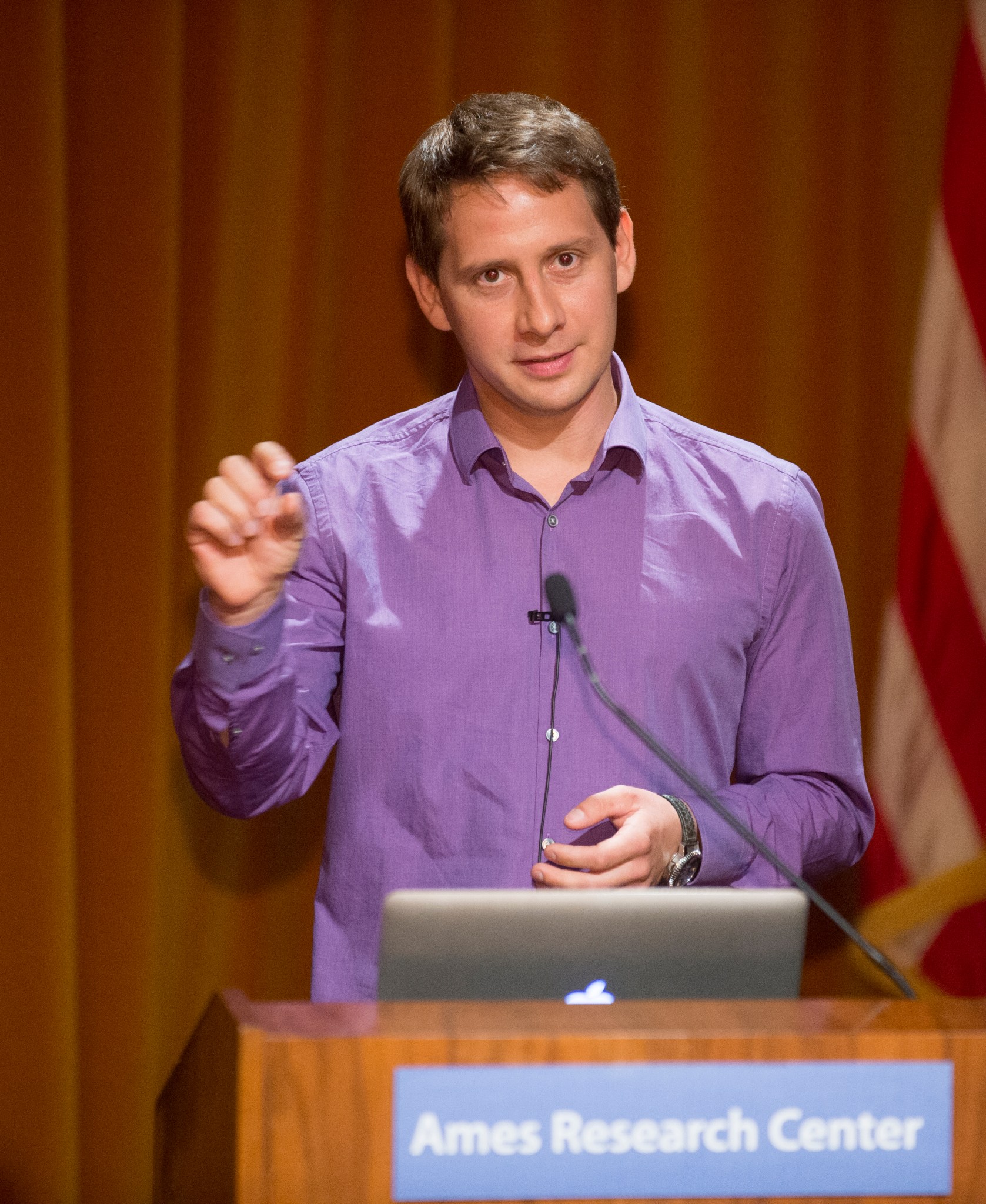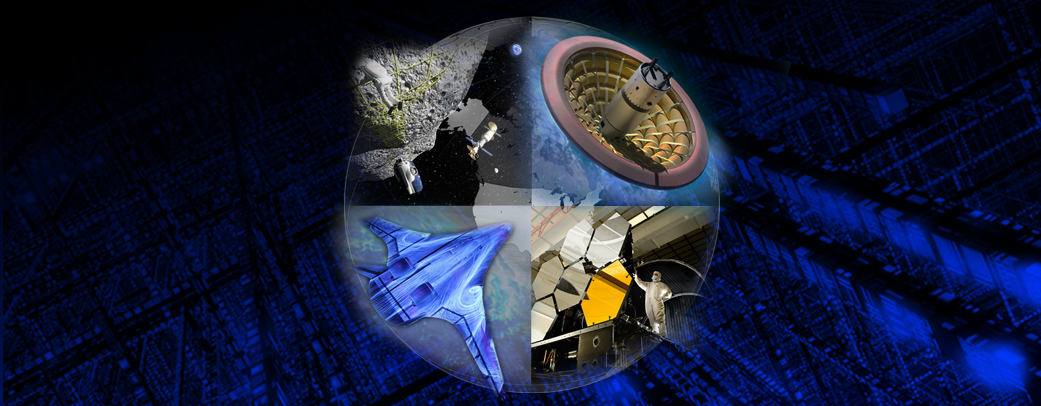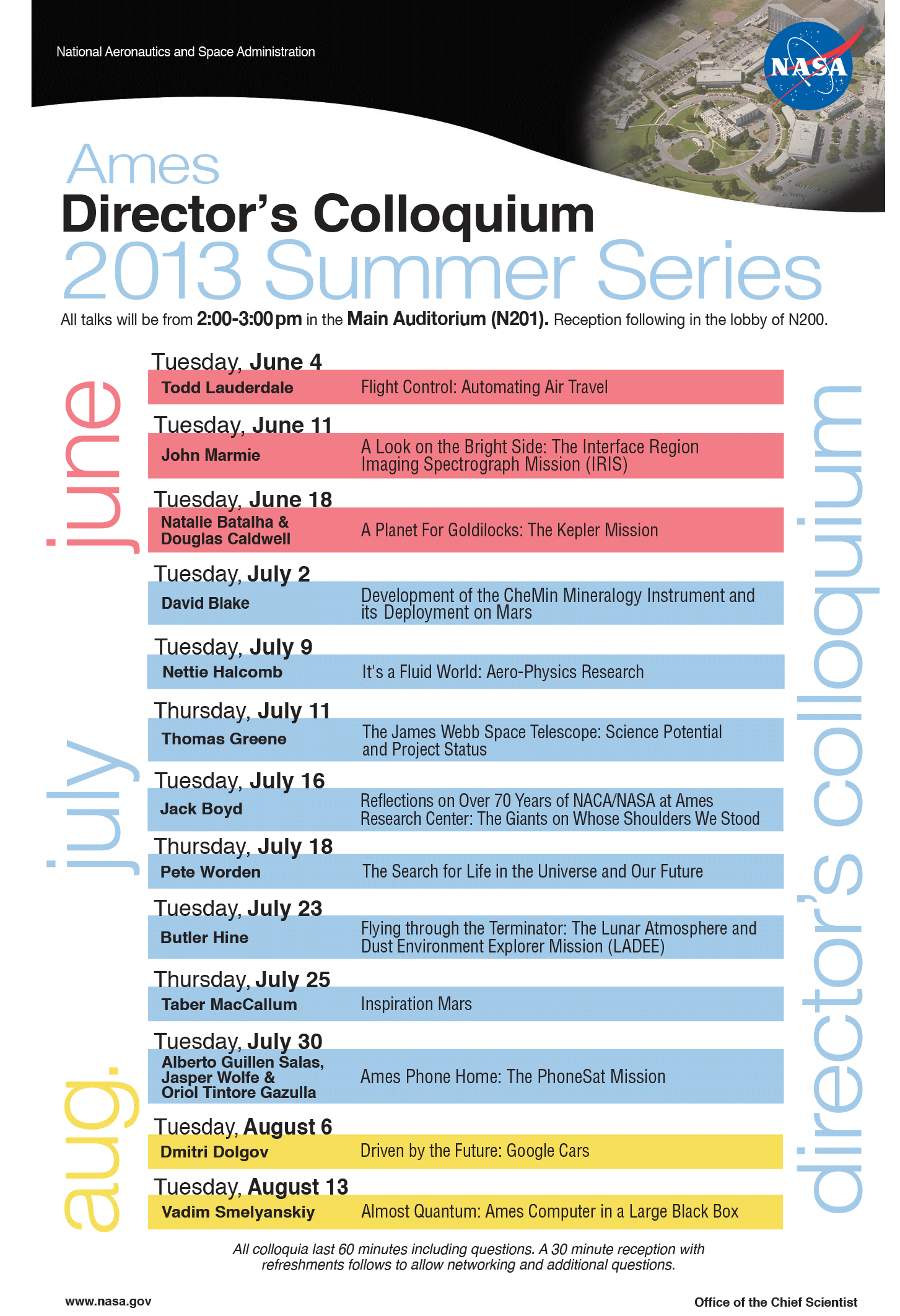 |
Todd Lauderdale
Flight Control: Automating Air Travel
This is an opportunity to learn about air traffic control and the automated control systems of the future.
Abstract:
Air traffic controllers are responsible for ensuring safe and efficient operations of more than 5,000 aircraft across the United States at any given time and more than 60,000 in a day. Although the present air traffic control system has an excellent track record for safety, the system reaches max capacity many times a day all across the US. When it does, controllers must delay flights in order to maintain safety. Such delays can ripple quickly across the country, resulting in lost productivity, wasted fuel and exasperated travelers. NASA Ames is conducting research to modernize the air transportation system, alleviate the choke points in today’s operations and maintain the free and efficient movement of people and goods. An overview of NASA’s Aviation Systems technology will be presented followed by discussion of an automation system designed to safely double the capacity of today’s system. Results of a nationwide simulation demonstrating the robustness and efficiency of this automated control system will be discussed as well as methods to further improve the system’s performance using large amounts of historical data.
Biography:
Todd Lauderdale has worked at NASA Ames for the past six years and is currently the technical lead for Separation Assurance at Ames, leading a research team focused on developing robust and highly automated tools for separation of en-route Separation Assurance of aircraft in the National Airspace System. Todd has a bachelors degree from the University of Texas at Austin and a Ph.D. from the University of California, Berkeley, all both in mechanical engineering.
John Marmie
A look on the Bright Side: The Interface Region Imaging Spectrograph Mission (IRIS)
The IRIS mission is scheduled to launch on June 26, 2013 from Vandenberg Air Force Base in California. The science prospects of IRIS as well as mission development and operations will be discussed, providing an insight into the workings of the sun, the core of our existence.
Abstract:
Just above the sun’s surface is an enigmatic region of the solar atmosphere called the interface region. This region, located just 5,000 to 10,000 miles from the surface of the sun, pulses with movement. The interface region contains zones of different temperature and density scattered throughout, while energy and heat course through the solar material. Understanding how energy travels through this region – energy that helps heat the next higher layer of the atmosphere, the corona, to temperatures of 1,000,000 Kelvin, some thousand times hotter than the sun’s surface itself, is the goal of NASA’s Interface Region Imaging Spectrograph, or IRIS. The talk will touch on science, but will focus more on the aspects of the IRIS mission development and operations.
Biography:
John Marmie is the Assistant Project Manager on the IRIS mission, working directly with and at Lockheed-Martin Solar and Astrophysics Lab in Palo Alto. John received a masters in electrical engineering from Ohio University and has been involved on multiple projects since starting at Ames in 1989, including the X-Wing, X-36, ARGUS, OPTIMA, Smart TPS, Personal Satellite Assistant, LCROSS and most recently IRIS. Less than one week after the successful lunar impact of the LCROSS mission, in which Marmie was the Deputy Project Manager, he began working on IRIS in a collaborative effort with the Lockheed-Martin Solar and Astrophysics Lab, Lockheed-Martin Sensing and Explorations Systems, the Smithsonian Astrophysical Observatory, Montana State University, Stanford, the Norwegian Space Centre and the University of Oslo. John is a passionate advocate for education and public outreach and has combined his passion for music and space exploration through songwriting, his latest full-length album is entitled “CURIOSITY.
Natalie Batalha & Douglas Caldwell
A planet For Goldilocks: The Kepler Mission
Launched in March 2009, the Kepler Mission’s primary goal is measuring the prevalence of potentially habitable planets in the Milky Way galaxy. The centuries-old quest for other worlds like our Earth has been rejuvenated by Kepler’s discovery of hundreds of planets orbiting other stars; we are not the only planet in the habitable zone. This NASA Ames based mission has changed the way we see the universe by showing that planets are ubiquitous.
Abstract:
The study of exoplanets has gone from speculation to first discoveries to statistical analyses of planet populations in the past 20 years, helped in large part by the launch of NASA’s Kepler spacecraft in March 2009. For the past four years, Kepler had been monitoring nearly 200,000 stars searching for Earth-size planets orbiting sun-like stars in the “habitable zone,” where liquid water could exist on the planet. To date, the Kepler team and the wider community have discovered over 3,200 planet candidates, hundreds of which are Earth-size. With the recent release of results from the first three years of observations, Kepler is turning up more and more small planets in the habitable zone, honing in on the answer to the question that drives the mission: are potentially habitable worlds common in our galaxy?
Biography:
Dr. Douglas Caldwell is a research scientist at the SETI Institute and a co-investigator and the instrument scientist for NASA’s Kepler Mission. He holds a bachelor’s in physics from Carnegie-Mellon University and a Ph.D. in physics from Rensselaer Polytechnic Institute in New York, where he studied how stars form in differing galactic environments. Caldwell came to NASA Ames on a postdoctoral fellowship in 1998 where he switched from stars to planets, working with William Borucki on the Vulcan project, one of the first ground-based searches for transiting exoplanets. He then led an international team to continue the search from the South Pole in order to take advantage of the long winter nights. Caldwell joined the Kepler Mission in 2001 and was named Instrument Scientist in 2006.
David Blake
Development of the CheMin Mineralogy Instrument and its Deployment on Mars
Using information recorded in sediments and rocks, the CheMin mineralogy instrument’s science goal is to identify and characterize past or present habitable environments. The instrument has the potential of allowing researchers to examine possible mineral biosignatures, energy sources, or other indicators, which provide clues to the age-old question; Has Mars once harbored life?
Abstract:
The CheMin instrument (short for “Chemistry and Mineralogy”) on the Mars Science Laboratory rover Curiosity is one of two “laboratory quality” instruments on board the Curiosity rover that is exploring Gale crater, Mars. CheMin is an X-ray diffractometer that has for the first time returned definitive and fully quantitative mineral identifications of Mars soil and drilled rock. From concept to space qualified instrument, CheMin’s 23-year development period will be discussed along with some of the discoveries that Curiosity has made since its entry, descent and landing on Aug. 6, 2012. This presentation also include the discovery and characterization of the first habitable environment on Mars.
Biography:
David Blake received a B.S. in biological sciences from Stanford University in 1973. After a stint in the US Navy, he attended graduate school at the University of Michigan, where he received a Ph.D. in geology and mineralogy in 1983. He came to Ames Research Center as a NRC postdoctoral fellow and became a research scientist in the Exobiology Branch at Ames in 1989. He was the Exobiology Branch Chief from 2000-2004. In nearly 25 years of research at Ames, he has studied astrophysical ices, interplanetary dust, Mars meteorites, lunar soils, stratospheric soot and the geology and mineralogy of ancient habitable environments on Mars. He is the principal investigator of the CheMin XRD/XRF instrument on the Mars Science Laboratory rover Curiosity, and is a member of the Principal Science Group that directs the activities of Curiosity during its two-year mission.
Nettie Halcomb
It’s a Fluid World: Aero-Physics Research
As we live in a fluid world, understanding how bodies move through fluids is of paramount importance. This presentation will provide insights into techniques used to measure the aerodynamic and aero-acoustic performance of aircraft and spacecraft of the future.
Abstract:
The Experimental Aero-Physics Branch (AOX) conducts research in aerodynamics and fluid mechanics using a wide variety of test facilities. The Fluid Mechanics Laboratory (FML), which is part of the AOX branch, is home to several experimental facilities, including six small-scale subsonic wind tunnels, a low-speed water channel, a laser optics lab, and an instrumentation development lab. In addition, the branch runs an acoustics lab with an anechoic chamber and an outdoor rocket test facility. Researchers in AOX use a variety of advanced measurement techniques to investigate the flow on and around aeronautical and aerospace models. This presentation will provide an overview of some of the techniques commonly used by members of AOX and how these techniques are combined to get a full understanding of the aerodynamic and aero-acoustic performance of the model under investigation. These techniques include: Pressure Sensitive Paint, Schlieren, Background Oriented Schlieren, Particle Image Velocimetry, Fringe Imagining Skin Friction and Photogrammetry Measurements. A few projects in which the AOX branch are involved in include: Crew Exploration Vehicle (CEV), MPCV (Orion), FAITH, Peregrine Hybrid Rocket, Rocket Motor Acoustics, CESTOL, Space Shuttle, Mars Science Lab (MSL), Sonic Boom Studies, Wake/Vortex Alleviation and Truck/Coal Car Aerodynamics.
Biography:
Nettie Halcomb received her BS in mechanical engineering from the University of Tennessee in 2008. She first came to Ames as a summer intern in 2007 and was hired full-time after she graduated in 2008. Nettie went to grad school while working at NASA and received her masters in mechanical engineering from Stanford University in 2011. Nettie focuses on making aerodynamic flow field and surface measurements using optical methods, mainly Pressure Sensitive Paint. She has worked on numerous tests in the Ames Unitary Plan Wind Tunnel Complex including CEV, Sonic Boom, Common Research Model and Bombardier Aerospace model tests.
Thomas Greene
The James Webb Space Telescope: Science Potential and Project Status
As space travel is our future, telescopes are not only an instrument to study future destinations but also a tool in understanding our past; understanding our past is a foundation to our future. The James Webb Space Telescope (JWST) will allow us to observe some of the very first luminous objects that formed in the universe, providing us with new insights into how galaxies assemble, stars are born and the very origins of life.
Abstract:
The unprecedented sensitivity and detail of the James Webb Space Telescope (JWST) will significantly advance a broad variety of astrophysics soon after it is launched in 2018. Its large (6.5-m diameter) primary mirror and infrared instruments distinguish it from the Hubble Space Telescope and will allow it to see some of the very first luminous objects that formed in the universe after the Big Bang. Other major science themes of JWST encompass studying the assembly of galaxies, the birth of stars and protoplanetary systems, and planetary systems and the origins of life. JWST will be the premier astrophysics space observatory for NASA and ESA over its 5 – 10 year mission lifetime, and many scientists will utilize its capabilities to make discoveries that we have not yet imagined.
JWST employs many unique technologies, and the mission has been in its development phase for over 10 years. Many major hardware components – all large optics and several science instruments – have been completed, and integration of major components has begun. The talk will illustrate the mission’s science potential and highlight the status of this development effort.
Biography:
Tom Greene is an astrophysicist at Ames Research Center where he has been working on NASA astrophysics observatories and conducting observations of young stars and extrasolar planets for the past 15 years. He received his PhD in astronomy from the University of Arizona in 1991 and then came to Ames as a National Research Council Postdoctoral Fellow. Greene then joined the research faculty of the University of Hawaii and the staff of NASA’s Infrared telescope facility. Before rejoining Ames, he worked on developing JWST and Spitzer Space Telescope science instruments at the Lockheed Martin Advanced Technology Center in Palo Alto.
Jack Boyd
Reflections on Over 70 Years of NACA / NASA at Ames Research Center: The Giants on Whose Shoulders We Stood
Jack originally traveled on a transcontinental train from Virginia to the San Francisco Bay Area to work at the National Advisory Committee for Aeronautics (NACA) at Moffett Field in 1947. NASA Ames is a leading research center that revolutionized the fields of aeronautics, space exploration, science, engineering and information technology, for both space and terrestrial applications; Ames changes the way we see and interact with the world. No one is more qualified to discuss the history of Ames than Jack.
Abstract:
Why explore? Much will be written as NASA reaches its 50th Anniversary this October. Jack Boyd will provide his personal view of the 66 years he has been with NACA and NASA by reflecting on the enormously talented individuals at Ames who helped develop the technology that made space exploration possible. Taking humans to the edge of their known world both requires new technology, and returns radical new insights into the world. Without exploration, science and engineering became routine and uninteresting. In this presentation, Mr. Boyd will explore how the NASA Ames Research Center has contributed scientific and engineering expertise to the exploration missions at the heart of NASA over its 50-year history. Also covered will be Ames’ work on the early manned space programs, the space shuttle, lunar science, planetary exploration, Mars and the prospects of life in the universe. Special attention will be paid to those giants who help make all of this possible.
Biography:
John W. Boyd (Jack) currently serves as Senior Advisor to the Center Director, the Senior Advisor for History and the Center Ombuds.
Jack has degrees from the aeronautical engineering program at Virginia Polytechnic Institute and State University (Virginia Tech), and the Sloan executive master of business administration program at Stanford University. Jack started at Ames in 1947, when it was the Ames Aeronautical Laboratory and still part of the National Advisory Committee for Aeronautics (NACA). He worked with some of the greatest aerodynamicists of his generation. His own work as an aeronautical research engineer involved wind tunnel studies of supersonic and subsonic aircraft and included major contributions to theories of conical camber. He later did early research on the design of unpiloted planetary probes to explore Mars and Venus, and he helped develop early configurations for the Mercury, Gemini and Apollo capsules.
Beginning in the mid 1960s, Jack increasingly served in managerial positions at NASA Ames. He served as Executive Assistant to the Ames Center Director, Deputy Director of Dryden Flight Research Center, Deputy and Associate Director of Ames Research Center and Associate Administrator for Management at NASA Headquarters. Additionally, he has served as Chancellor for Research for the University of Texas System. He has also been an adjunct professor at the University of Texas (Austin, El Paso and Pan American campuses), teaching courses in aerodynamics, introductions to engineering and the history of spaceflight.
Jack has earned many awards, including the Stanford Sloan Fellowship, the NASA Exceptional Service Award, the NASA Outstanding Leadership Award, the NASA Equal Employment Opportunity Medal, the Presidential Rank of Meritorious Executive, the NASA Distinguished Service Medal and the Army Command Medal. He is also a Fellow of the American Institute of Aeronautics and Astronautics (AIAA).
As Senior Advisor for History, he continues to lecture frequently about the culture of Ames and how its leadership has evolved to fit the needs of the time. In addition, he has his own research and writing projects and ensures that the work of the Ames History Office continues to explore how the Center’s past is relevant to its future.
Jack is married to Winifred G. Boyd, and has five children and nine grandchildren.
Pete Worden
The Search for Life in the Universe and Our Future
The pursuit for evidence of life in the universe is one of humanity’s most extraordinary endeavors. Probing where we come from, if we are alone, as well as determining where we are going next, is of paramount importance to space exploration. NASA Ames Research Center is at the forefront of this endeavor. In his talk, Ames Center Director S. Pete Worden will illuminate on just how this endeavor is being pursued.
Abstract:
As we continue to seek for evidence of life beyond Earth, two sources of new data come to the fore. The first is our search for places that could support life. Locations where liquids and sources of energy exist have been the focus of NASA’s recent efforts. We’ve found a number of such places in the solar system where these requirements might be met. Recently, we’ve begun to identify numerous planets in other solar systems that could, in principle, have liquid water on their surfaces. A second new source of insight into our search for life comes from our own technology development. In particular, the emerging field of synthetic biology suggests that we ourselves ¬ and presumably extraterrestrial intelligence could engineer life to exist in much broader ranges of conditions that we find on the Earth’s surface. In this lecture the status of these two developments and their implications for our search for life will be discussed.
Biography:
Dr. Simon P. Worden (Brig. Gen., USAF, ret.) is the center director at NASA Ames Research Center where he leads a staff of nearly 2,500 civil servants and contractors, and oversees an annual budget of approximately $800 million providing the critical R&D support that makes NASA’s and the nation’s aeronautics and space missions possible. Prior to becoming Ames director, S. Pete Worden was a research professor of astronomy, Optical Sciences and Planetary Sciences at the University of Arizona where his primary research direction was the development of large space optics for national security and scientific purposes and near-earth asteroids. Additionally, he worked on topics related to space exploration and solar-type activity in nearby stars. He is a recognized expert on space issues both civil and military. He has authored or co-authored more than 150 scientific technical papers in astrophysics, space sciences, and strategic studies. Moreover, he served as a scientific co-investigator for two NASA space science missions.
Butler Hine
Flying through the Terminator: The Lunar Atmosphere and Dust Environment Explorer Mission (LADEE)
Led by NASA Ames Research Center, LADEE is a small lunar orbiter that will determine the composition of the lunar atmosphere as well as whether dust is present in the lunar exosphere. Designed at NASA Ames, LADEE is a space exploration mission based on a modular architecture. Such innovative architectures reduce risk and cost by standardizing certain components across the missions. LADEE will also be testing an optical communications system that could enable high-bandwidth communications links, expanding our capabilities for future planetary and exploration missions.
Abstract:
The Lunar Atmosphere and Dust Environment Explorer (LADEE) mission is atypical for NASA, and represents several “firsts” for both the agency and Ames. LADEE is a Lunar science orbiter mission with a planned launch date of September 6 this year. The science objectives are to determine the composition of the lunar atmosphere and investigate the processes that control its distribution and variability, including sources, sinks and surface interactions. LADEE also will determine whether dust is present in the lunar exosphere, and reveal the processes that contribute to its sources and variability. What makes LADEE unusual, however, is that the mission also has several other non-science objectives. In addition to the science instruments, LADEE also will fly a laser communications system technology demonstration that could provide high-bandwidth capabilities for future space communications architectures. The LADEE spacecraft is the first flight of a multi-mission spacecraft bus architecture, called the Ames Modular Common Bus, which is adaptable to multiple payloads and destinations. LADEE also will launch from the Wallops Flight Facility on a new launch vehicle, the Minotaur V, from a range that normally does not launch planetary missions. All of these “firsts” make LADEE an interesting mission, especially when done using a low-cost approach.
Biography:
Dr. Hine is currently the project manager for the Lunar Atmosphere and Dust Environment Explorer (LADEE) mission, a lunar science orbiter planned to fly in 2013. Prior to LADEE, Dr. Hine managed the Small Spacecraft Division at NASA Ames Research Center, which developed ways to build low-cost, high-performance spacecraft to enable future NASA missions. Prior to his current assignment, he managed various NASA programs, such as the Robotic Lunar Exploration Program, the Computing, Information, and Communications Technology Program, and the Intelligent Systems Program. He has published over 60 journal and conference papers in the areas of spacecraft design, astronomy, optical instrumentation, machine vision, robotic planetary exploration, and 3D visualization. Butler Hine received his bachelor of science degree in physics and mathematics, summa cum laude, from the University of Alabama in 1981, and masters and doctorate degrees in astronomy from the University of Texas in Austin in 1985 and 1988, respectively.
Taber MacCallum
Inspiration Mars
Due to the alignment of planets in 2018, there exists a unique free-return orbit opportunity to travel from Earth to Mars and back in only 501 days. Inspiration Mars is planning on capturing this opportunity by sending a two-person crew around the Red Planet and return them safely to Earth. An important part of the mission is to stimulate interest in Science, Technology, Engineering and Mathematics (STEM) education. The science objectives of the mission focus on human endurance and psychology. Taber MacCallum of Paragon Space Development Corporation will speak on how this novel mission is focused on inspiring humanity to dream big.
Abstract:
Inspiration Mars is a human mission to fly by Mars that takes advantage of a rare fast free return Mars flyby trajectory in January 2018. The Inspiration Mars Foundation headed by Dennis Tito, plans to pursue a challenging manned mission to Mars and back. This historic 501-day journey around the Red Planet will have two crew members – one man, one woman – flying within 100 miles (160 km) of Mars before swinging back and safely returning to Earth. Target launch date is Jan. 5, 2018. MacCallum will describe the mission as well as some of its programmatic and technical challenges and opportunities. NASA Ames is actively supporting the mission under a Space Act Agreement for analysis of the reentry and thermal protection systems.
Biography:
Taber MacCallum is a Paragon co-founder and is responsible for overseeing business development, proposals, marketing, branding, customer relations, strategic partnerships, technology development and IP. MacCallum is co-designer and patent holder for the Autonomous Biological System, a long duration plant and aquatic animal life support system. He conceived and is presently involved in the design of a novel Mars space suit portable life support system technology funded by NASA, life support and thermal control systems for commercial manned orbital and suborbital spacecraft, as well as hazardous environment life support technology for U.S. Navy divers, in which he is the test diver. In 2008, Popular Science named MacCallum Inventor of the Year. Prior to Paragon, he was a founding member of the Biosphere 2 Design, Development, Test and Operations team, and a crew member in the first two-year mission. MacCallum has worked at every level of command on a research vessel, sailing more than 40 ports and more than 30,000 miles around the world. MacCallum was the principal investigator on five microgravity experiments starting in 1988 on the Soviet BioSatellite, then the U.S. space shuttle, the Russian Mir Orbital Station and International Space Station.
Alberto Guillen Salas, Jasper Wolfe & Oriol Tintore Gazulla
Ames Phone Home: The PhoneSat Mission
PhoneSat is an example of adapting existing technologies for adaptive uses for novel uses which reduces overall costs, schedule and risks. NASA successfully launched three smartphone satellites on April 21, 2013. The satellites, Alexander, Graham and Bell are named after the inventor of the telephone. Their mission is to prove how affordable space can be, opening it up to everyone. The PhoneSat Project has recently been awarded with a Popular Science 2012 ‘Best of What’s New’ award in the aviation category. NASA Ames was able to phone home from space while inspiring humanity that space access is within anyone’s reach.
Abstract:
As consumer technologies are rapidly evolving the utilization of these technologies for low-cost space missions is becoming prevalent. Over the last decade consumer technology devices have reinvented our ability to figure out where we are, which way we are pointing, observe the world around us, and store and transmit such information to whomever and wherever we desire. Previously sold as separate products, such as GPS units, digital cameras and mobile phones – these are now combined into one as a ‘smartphone.’ Ironically, the capabilities of these devices are more powerful than those which are required to run multi-million dollar satellites – so the question is, why not use a multi-hundred dollar smartphone for such a function? The PhoneSat project of NASA Ames Research Center is developing technology demonstrations to show to the world just how simple and inexpensive Space can be. The style of development revolves around the Silicon Valley “release early, release often” mentality. Earlier this year, PhoneSat launched a triage of PhoneSat’s into low earth orbit. In their six-day orbital life, the nano-satellites flew the first functioning smartphone based satellites (Nexus One and Nexus S), the cheapest satellite ever flown ($3,500) and the satellite with the fastest on-board processor (1GHz).
Biographies:
Oriol Tintore Gazulla is an Aerospace Engineer working for PhoneSat and EDSN projects at NASA Ames Research Center. He received his bachelor’s and master’s degrees from the Polytechnic University of Catalunya (Spain) in 2011. Oriol has been working at Ames since 2011 where he has been able to work on three satellites that successfully flew on April 2013. Oriol is in charge of the mechanical design and the mission analysis for the PhoneSat project, which is trying to lower the cost of satellites to make space missions affordable to everyone.
Alberto Guillen Salas is currently working on both PhoneSat and EDSN technology demonstration missions. Alberto has been working at NASA Ames Research Center for the past two years. He received his Master’s degree in Aerospace Engineering from both the Universidad Politécnica de Madrid (Spain) and the École Nationale Supérieure de l’Aéronautique et de l’Espace (France) in 2011.
Jasper Wolfe is an Aerospace Engineer with a passion for making garage Space exploration possible. He is currently working on the PhoneSat and EDSN projects at NASA Ames Research Center, creating nano-satellite technology demonstrations using smart phones, consumer technologies and open source operating systems. Jasper grew up in Australia and has studied at the University of Queensland (Australia) and Purdue University (USA). He has been at NASA Ames since 2011 and has been actively involved in aerospace since high school. Through conferences and workshops, Jasper has come to enjoy actively engaging secondary and tertiary level students in the future of Space.
Dmitri Dolgov
Driven by the Future: Google Cars
What would automobile driving be like in the future? Could we have vehicles that do not require human interaction? The team at Google is working to develop an automated car that drives itself by utilizing advanced robotics technology.
Abstract:
Self-driving cars will transform mobility by making transportation safer and more efficient, and by giving people back the time currently wasted on the manual operation of vehicles. In 2009, Google started a self-driving-car program to rapidly advance autonomous-driving technology. Building on previous work in the field, we have developed a small fleet of vehicles that to date have autonomously driven over a million kilometers in complex real-world conditions. In this talk, the history of the project, the technology used by our cars, the challenges that lie ahead and the future of autonomous driving will be discussed.
Biography:
Dmitri Dolgov is a senior staff engineer at Google who leads the team responsible for developing the algorithms and software that run on the Google self-driving car. He received his B.S. and M.S. in physics and math from the Moscow Institute of Physics and Technology in 1998 and 2000, respectively, and his Ph.D. in computer science from the University of Michigan in 2006. Prior to joining Google, Dmitri worked on Stanford’s robotic car Junior, which placed second in the DARPA Urban Challenge competition in 2007. In 2008, Dmitri was named one of “AI’s ten to watch — the Future of AI” by the IEEE Intelligent Systems Magazine.
Vadim Smelyanskiy
Almost Quantum: Ames Computer in a Large Black Box
Quantum computing is still in its early stages, experiments have been carried out in which quantum computational operations were executed on a very small number of qubits (quantum bits). Quantum computers promise to revolutionize the way analysis is performed by harnessing the power of quantum physics parallelism to solve complex optimization problems. Is the future world a quantum Apps world?
Abstract:
Quantum mechanics underlies the engineering of new materials, powerful electronic components and fast telecommunication channels. In last decade, the quantum mechanical tunneling phenomenon was ultimately responsible for breaking the Moore’s law of computer speed growth because it limited the miniaturization of devices. However, recent advances in the new area of quantum computation show how it can be controlled to manipulate information in a fundamentally new way. The quantum computing race has begun: researchers are investigating varied approaches theoretically and experimentally to manipulate quantum bits (qubits) according to the laws of quantum mechanics, a tricky task given the fragility of qubit states. As quantum hardware emerges, NASA’s Quantum Artificial Intelligence Laboratory (QuAIL) team will lead efforts, studying in depth the performance power of the D-Wave Two quantum-annealing computer for solving hard optimization problems. This 512 qubit machine was recently installed at NASA Ames in partnership with Google and USRA. It is hosted now in a specially shielded room in the NASA Advanced Supercomputing (NAS), with the processor maintained in a protected state vacuum at a temperature of a few tens of milliKelvin. This presentation will describe basic physics principles of its operation, journey into quantum tunneling effects that empower its computation and explain how to program it by mapping computationally challenging NASA tasks onto this machine’s unique architecture.
Biography:
Dr. Vadim Smelyanskiy is a principal scientist for Physics Based methods in the Exploration Technology directorate. He leads the Integrated Product Team on Physics Based methods that includes the quantum computing group. Smelyanskiy received his Ph.D. degree (1992) in theoretical physics from the Institute of Semiconductors, Kiev, Ukraine. Prior to joining NASA, Smelyanskiy was working as a research fellow in the Quantum Control group at the Department of Chemistry, Princeton University. During his tenure at NASA, Smelyanskiy has been the principal investigator on a number of projects funded by NASA and other government agencies. He and his team supported the physics analysis Constellation program, Exploration Technology Development program, Space Launch Systems, Space Technology Mission Directorate and other NASA programs and missions. In the quantum area, he was involved in the NASA Revolutionary Computing Program and in the ARO Quantum computing program for many years. His work focuses on physics analysis in many areas of classical physics, including cryogenics, explosions, physics of failure and others. In quantum domain, Smelyanskiy’s work is focused on solid state devices for quantum computing, and development of quantum algorithms such as quantum annealing for solving hard optimization problems.

























